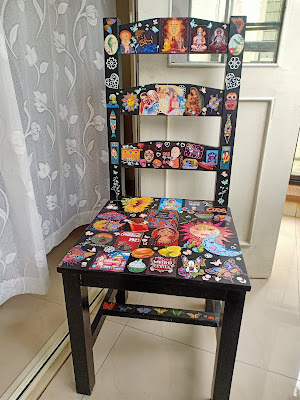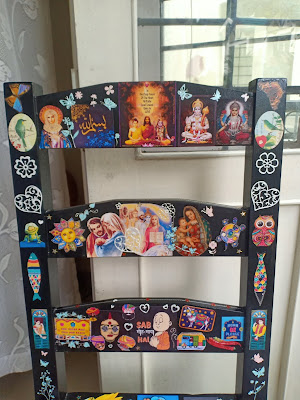My trip to the hills of Quepem (with excerpts from the Navhind Times regarding the organisation)
A tiny group of
young, enthusiastic entrepreneurs have ventured into the remote villages of
Goa, their aim is to “promote interaction and exchange of values between the guests and the
inhabitants of the village”. In other words “Building folk communities”.
Folk Living is a Goa based
organisation that works for the promotion and preservation of Indian culture. The three co-founders are Shreyash Diukar, Mansi Kumbharjuvekar and Priyanka Goyal.
They hosted a group of people in
Basrai village of Quepem, South Goa, to experience the forgotten, traditional
folk lifestyle of Goa. They want their
guests to experience and adopt a simple, healthy lifestyle.
Whilst the tribal folk are accepting modernity,
they are making sure their culture is safe and preserved. The lifestyle of
these villagers is still authentic. They live in mud houses with cow dung covered floors (more of that later), they eat what they cultivate and cook in earthen pots passed on
to them by their ancestors.
Situated 15 minutes
away from Cuncolim, in Quepem Taluka, Basrai has about 10-15 houses, of which
at least four or five houses belong to the tribals of that area.
I was very fortunate to be a part of
their first trail to a village in the hills of Quepem. We were a small group led by a very enthusiastic Shreyas
Diukar. Alongwith him was the lovely Mansi, a photographer and
film maker.
Shreyas very kindly met me at the pickup point which was at Kadamba bus terminal in Margao city. We drove through green arches, past verdant vistas, cashew, palm, mango and reca nut plantations.
From the main road an almost obscure
track led to the upper region. We then alighted and walked along very narrow
paths up and past dried paddy fields, to the sound of rushing water, to a
rustic home, made of laterite bricks and a tiled roof. The floors were
coated with dried cow dung. This keeps the home cool as also pests away. The
rooms were dim and cool.
In the backyard, three women were cooking over
a wood fire. No gas, no kerosene. Just three laterite blocks put together
to hold the cooking vessel and firewood collected from the forest for fuel.
Large wood sheds hold logs of wood in storage. The bathroom is just
a shed with palm thatch on top and three sides. Bath water is heated in a
huge copper “modki”.
To start with we were given a snack of home grown bananas and long
slices of cucumber to eat. They grow really large cucumbers here. Water
was from a spring near by.
Heaps of red chilies were drying in the
sun. There was also lemongrass, okra, sweet potatoes and green leafy
vegetable which we call val bhaji growing in abundance. Betel nuts were
also drying in the sun.
The hills slope to groves of cashew trees. Banana and
coconut trees grow in abundance as also curry leaf trees and some medicinal
creepers that resemble orchid buds.
The villagers are charming in their own special way…. simple and
hospitable. As they were expecting visitors, help arrived from the neighbouring
village. Extra, willing hands cooked our lunch.
In another hut, a man was happily cleaning fish for our meal. Sooo endearing !
Shreyash led us down to the gently flowing Sal River.....past
wild marigold and neon yellow cosmos, bushes of lantana, alamanda, tall fragrant grasses and the rich aroma
of trodden grass. It felt simply great to be alive.
Down by the river we sat on small
boulders, my feet in the water, tickled by the tiny fish that swam there,
basking in the leaf dappled sunshine.


Suddenly, the laterite boulder that
held my ample weight toppled and I was knee deep in the clear water frantically
trying to get a hold. Shreyas was near by and so was my friend who
accompanied me on this trek. All I could think of was saving my phone. I was helped to firmer ground and sat again
on another boulder this time making sure it was secure. Thankfully my phone was dry. Off came my
shoulder bag and up into an overhanging branch it hung. My behind was
soaked and I didn’t mind that but later, much to my chagrin, I was told that I
had a tear in my flimsy cotton trousers on the seat, possibly revealing my
underwear. Awful moments wondering who had seen it ! I was reassured by one of the girls that “nothing
can be seen”. I didn’t believe her. Very
bravely but gingerly I climbed the path up to the house.
Sunanda offered me her trousers, drying on the clothesline. Never
did I feel so grateful for a garment . Next time I vow I will wear
jeans.

With Sunanda (in pink tunic) and Gouri Gaonkar. Sunanda is the only girl from this village who is studying at the Goa University. Gouri is her friend from university who lives in Quepem and travels up to this village to catch up with Sunanda.
Now dry and comfortable, in the backyard I was offered a seat so I
could watch the ladies now making our dessert or tea snack. There was
rice paste in one container and another held the filling made of freshly grated
coconut and palm jaggery. Jackfruit tree leaves were rolled to form cones and
secured with fine sticks. These cones were lined with the rice paste,
filled with the coconut jaggery, sealed on top with the rice paste, and steamed
in old fashioned 'confro' or copper steamer like my grandmother and mother used to, way back in the ‘50s.



In the courtyard we sat on straw mats and were served food on banana
leaves. Lunch was delicious. Brown rice from their paddy fields,
dry fish and prawn curry, fresh fish curry, mixed vegetable katkate, green
pumpkin in coconut gravy, potato slices fried in semolina batter, pickle and
tomato-cucumber salad. The best item on the already scrumptious menu was bangda
(mackerel) roasted directly over a fire. Blackened on the outside but cooked
perfectly on the inside.
Note the khullar or earthenware water container. Spring water.
I love this pic of Shreyas with his "Aiee"
(Namlesh is in the background)
The warm afternoon was spent painting pots with natural dyes. Namlesh, the bull browsed nearby.
Just out of curiosity I asked Shreyas why he was named Namlesh and he
replied simply because he was not given a name before that. So Nameless was bestowed with the name Namlesh
!
Getting back to the painting, these
pots were actually small drums used on special occasions. The mouths were
covered with cow hide tied with hemp string.
One of the ladies played the drum and
sang a folk song. Later she demonstrated peeling the thick husk of a
coconut with her bare teeth.
Steaming black tea laced with jaggery was served with the rice
cones. Mouth watering !
Late evening we reluctantly left this tranquil place. But not
before those wonderful, generous ladies packed leftover tea snack, those
scrumptious rice cones, for Shreyas and me to take home. It had been obvious we were sugar freaks.
What a day ! What an experience !
Folk Living also plans to partner
with NGOs working in various other fields to support the communities and
strengthen their livelihood.
The organisation is based on the
concept of chartered eco-tourism that caters to a limited number of people
without compromising on the experience and lifestyle of the villagers. They
plan their events and decide on the number of guests. Hence, the group size is
limited to about ten people. They believe travelling with a small group makes
the experience attractive and collaborative as also keeping in mind the comfort
and willingness of the villagers to host that many people,”
Folk Living plans on selling artworks, paintings and other handicrafts from local
artisans and also promoting musicians, folk dancers and other such groups
through a YouTube channel.
Pics below courtesy Folk Living:
Till the next time.
Lena































